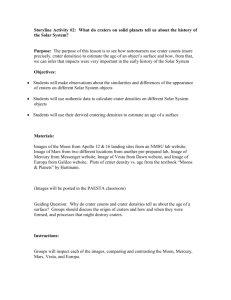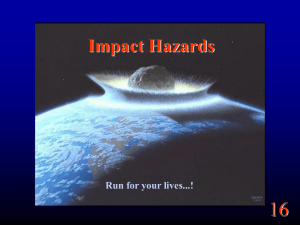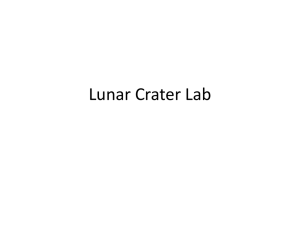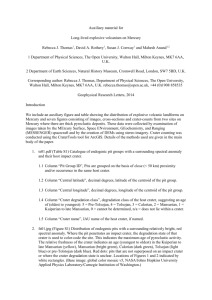Stratigraphy of Aeolis Dorsa, Mars: Stratigraphic context of the great
advertisement
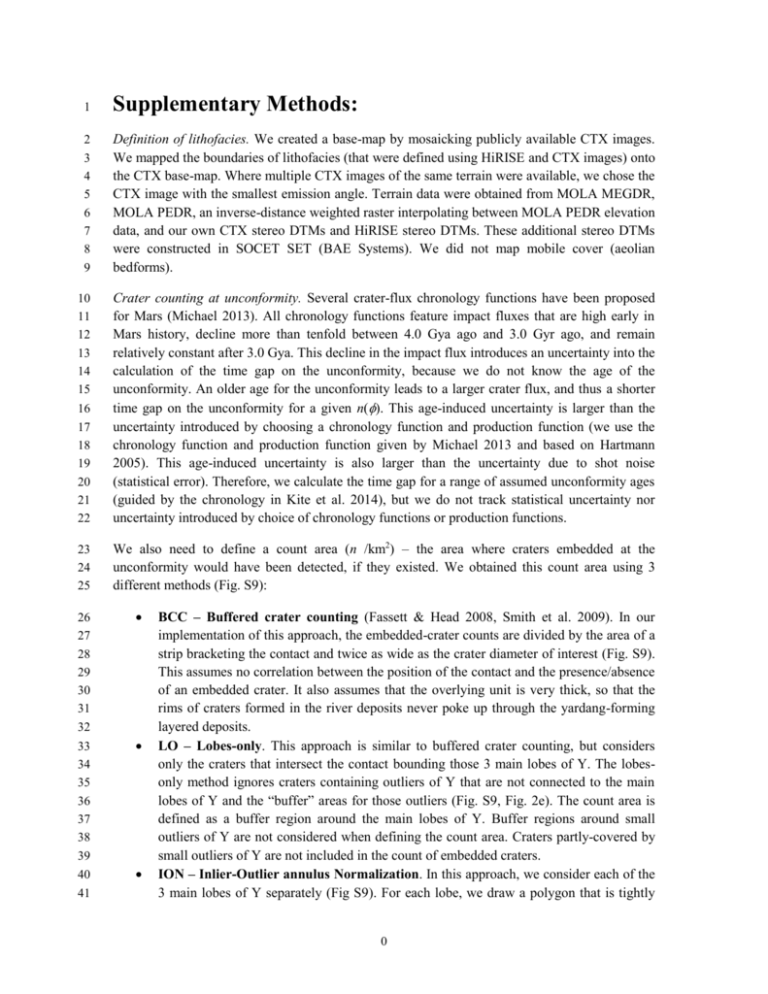
1 Supplementary Methods: 2 3 4 5 6 7 8 9 Definition of lithofacies. We created a base-map by mosaicking publicly available CTX images. We mapped the boundaries of lithofacies (that were defined using HiRISE and CTX images) onto the CTX base-map. Where multiple CTX images of the same terrain were available, we chose the CTX image with the smallest emission angle. Terrain data were obtained from MOLA MEGDR, MOLA PEDR, an inverse-distance weighted raster interpolating between MOLA PEDR elevation data, and our own CTX stereo DTMs and HiRISE stereo DTMs. These additional stereo DTMs were constructed in SOCET SET (BAE Systems). We did not map mobile cover (aeolian bedforms). 10 11 12 13 14 15 16 17 18 19 20 21 22 Crater counting at unconformity. Several crater-flux chronology functions have been proposed for Mars (Michael 2013). All chronology functions feature impact fluxes that are high early in Mars history, decline more than tenfold between 4.0 Gya ago and 3.0 Gyr ago, and remain relatively constant after 3.0 Gya. This decline in the impact flux introduces an uncertainty into the calculation of the time gap on the unconformity, because we do not know the age of the unconformity. An older age for the unconformity leads to a larger crater flux, and thus a shorter time gap on the unconformity for a given n(). This age-induced uncertainty is larger than the uncertainty introduced by choosing a chronology function and production function (we use the chronology function and production function given by Michael 2013 and based on Hartmann 2005). This age-induced uncertainty is also larger than the uncertainty due to shot noise (statistical error). Therefore, we calculate the time gap for a range of assumed unconformity ages (guided by the chronology in Kite et al. 2014), but we do not track statistical uncertainty nor uncertainty introduced by choice of chronology functions or production functions. 23 24 25 We also need to define a count area (n /km2) – the area where craters embedded at the unconformity would have been detected, if they existed. We obtained this count area using 3 different methods (Fig. S9): 26 27 28 29 30 31 32 33 34 35 36 37 38 39 40 41 BCC – Buffered crater counting (Fassett & Head 2008, Smith et al. 2009). In our implementation of this approach, the embedded-crater counts are divided by the area of a strip bracketing the contact and twice as wide as the crater diameter of interest (Fig. S9). This assumes no correlation between the position of the contact and the presence/absence of an embedded crater. It also assumes that the overlying unit is very thick, so that the rims of craters formed in the river deposits never poke up through the yardang-forming layered deposits. LO – Lobes-only. This approach is similar to buffered crater counting, but considers only the craters that intersect the contact bounding those 3 main lobes of Y. The lobesonly method ignores craters containing outliers of Y that are not connected to the main lobes of Y and the “buffer” areas for those outliers (Fig. S9, Fig. 2e). The count area is defined as a buffer region around the main lobes of Y. Buffer regions around small outliers of Y are not considered when defining the count area. Craters partly-covered by small outliers of Y are not included in the count of embedded craters. ION – Inlier-Outlier annulus Normalization. In this approach, we consider each of the 3 main lobes of Y separately (Fig S9). For each lobe, we draw a polygon that is tightly 0 42 43 44 45 46 47 48 wrapped around neighboring outliers of Y – connecting their outermost apices with straight lines. This polygon defines the outer boundary of the annulus of inliers and outliers for that lobe. Next, we draw a polygon that connects the innermost apex of all inliers of sub-Y materials with straight lines. This polygon defines the inner boundary of the annulus of inliers and outliers for that lobe. We define the annulus between the polygons as the inlier-outlier annulus. We use the combined area of the 3 inlier-outlier annuli (one annulus for each lobe) to calculate the crater densities. 49 50 51 52 53 54 55 56 57 58 59 60 61 62 63 64 65 66 Count areas obtained using methods LO and ION are more realistic than using count method BCC. We can see this by first noting that outliers of Y are preferentially preserved in embeddedcrater interiors (e.g. Fig. 19a), where they are protected against the wind1. Imagine (as a thought experiment) that the large lobes of Y were entirely removed, so that the only Y remaining was the material preferentially preserved in embedded-crater interiors. Then, because every part of the perimeter of Y would partly cover a crater, buffered-crater counting would return a fractional crater cover close to 100% (crater saturation). The resulting (over-)estimate for the time gap on the unconformity is the oldest time gap possible. The long-gap bias will be less severe for a realworld count than the absurdly high age resulting from this thought experiment, but the bias will still be in the direction of overestimating the time gap at the unconformity. Methods ION and LO attack this time-gap-overestimation by taking account of correlations between the position of the Y/sub-Y contact and the location of embedded craters (Fig. S9). In method ION, the current area spanned by the farthest-flung outliers of Y is taken to correspond to the area within which some Y would be preserved, if there were embedded craters present to protect them from obliteration by the wind. In method LO, we count only craters that intersect the margins of one of the three main lobes of Y. These margins are in erosional retreat, but the current position of the margins is not obviously correlated with the locations of embedded craters. Therefore such craters should not suffer from the age-overestimation bias adhering to the BCC method at this location. 67 68 69 70 71 72 The results (Table 1) are consistent with our expectations. The BCC method produces an impossibly large time gap (larger than the age of Mars). The LO and ION methods produce more realistic (lower) time gaps. There are fewer small craters embedded at the unconformity than expected for a pristine population of craters. This is consistent with preferential undercounting of smaller craters due to geometric effects (Lewis & Aharonson, 2014), survey incompleteness, obliteration by erosional processes (Jerolmack & Sadler 2007), or some combination. 73 74 Supplementary Discussion: 75 76 77 Crater-river interactions indicate one or more additional unconformity involving the river deposits (shown by wavy lines within R-1 and R-2 in Fig. 20), although we are not sure if these unconformities are basinwide. The evidence for this additional unconformity is as follows. Intra1 Preferential formation of layered deposits within craters has also been suggested (Brothers & Holt 2013; Figure DR3 in Kite et al. 2013c). The craters considered in those studies are generally larger than the craters considered in this study, and we assume for the purposes of this study that ≲10 km craters in Aeolis Dorsa aided preservation (not formation) of Y. 1 78 79 80 81 82 83 84 85 86 87 88 89 90 91 92 93 94 95 96 97 98 99 100 101 102 103 104 105 106 107 108 crater sinuous ridges exist within Kalba, Neves, Obock, and the unnamed crater at 153.5°E 3.8°S. These ridges are best seen within Kalba crater (ESP_034545_1740). Because the ridges are sinuous and parallel to the paleo-drainage direction defined by sinuous ridges and meander-belts outside the crater, we interpret them as inverted channels (Burr et al. 2009). The inverted channels are 400m lower than the rim of Kalba and only 3 km from the rim. Remarkably, the inverted channels do not correspond to breaches in Kalba’s rim. Some knicks are found in the N and the S rim of Kalba (parallel to paleoflow and suggesting fluvial incision), but they do not extend as deep as the inverted channels within Kalba, nor are they aligned with the interior channels. This lack of deep rim breaching presents a paradox: how could water have flowed over the rim of Kalba (as required to form the inverted channels in Kalba’s interior) without deeply incising the rim? The resolution of the paradox is that the fluvial deposits were laid down at a time when the landscape had aggraded above the level of the crater rim. Therefore, the river deposits formed at a paleo-elevation above the crater rim. (This also explains why the sinuous ridges are aligned with the regional drainage direction and do not respond to the topography of the rim). Still further aggradation led to compaction (Lefort et al. 2012). The thickness of compactible material within Kalba was greater than the thickness of compactible material outside Kalba, because a = 14 km crater (Kalba’s diameter) forms a ~1.66 km deep hole (Tornabene et al. 2013). This contrast in thickness of compactible material drove differential compaction (Lefort et al. 2012, Buczkowski et al. 2012), such that the river deposits which formed topographically above the rim are now below the river deposits on the surrounding plains. Other locations showing knicked rims preferentially in regional upstream-downstream directions and/or intracrater river deposits are Obock, Neves (ESP_035600_1765), and the unnamed craters at 153.1°E 5.8°S, 153.5°E 3.8°S (ESP_027807_1765/ ESP_035112_1765 stereopair), and 152.6°E 6.3°S. The existence of knicks in the crater rims and of intra-crater river deposits points to an interval of aggradation to above the level of the crater rims, and an interval of incision to cut the crater rims. The relative timing of the knicks is unknown. It is also unknown whether the incision was restricted to the vicinity of preexisting crater rims, or represents an additional basinwide unconformity. However, a thick stack of now-vanished material above the current level of the crater rims is required to explain the current elevations of the inter-crater sinuous ridges. Supplementary Figures: 2 109 110 111 112 113 114 Figure S1. Materials outcropping in our study area, but not assigned to one of the sedimentary rock packages in Figure 2. Aeolis rise sedimentary materials and Asau rise sedimentary materials probably postdate river deposits (Zimbelman & Scheidt 2012), but may unconformably predate them. Figs. 17 and S8 show these alternatives. Lava in the N of the study region embays Aeolis Serpens river deposits (Kerber & Head, 2010). 115 3 116 a) 117 b) 118 c) 4 119 120 121 122 123 Figure S2. (a) Southernmost inlier of B (low-lying, heavily cratered material). Boundary scarp is ~100m high. Lowermost floor elevation is ~-2760m (from PEDR). Note wide spacing of PEDR tracks (columns of black crosses). (b) Part of central large inlier of B. Boundary scarp is ~150 m high. Lowermost floor elevation is ~-2700m. (c) Part of northernmost inlier of B. Floor elevation is -2840m. Boundary scarp is ~200m high. 124 a) 125 b) 5 126 127 128 129 130 131 132 133 134 135 136 137 138 139 Figure S3. (a) Channels crosscut a 1.5km-diameter crater formed in Neves ejecta, suggesting ≳3 × 108 yr elapsed between the Neves impact and channel incision. Example shown by red arrow. These channels cannot result from localized runoff triggered by the Neves impact, because localized impact-triggered runoff shuts down much faster (10-5-103 yr; Kite et al. 2011, Mangold et al. 2012) than the expected wait time for ≥ 1 km diameter impacts on the 270 km2 area of remnant Neves ejecta (>3 × 108 yr using a typical Hesperian impact flux; Michael 2013). There is also no evidence for point sources of surface water near Neves, such as volcanic vents or chaos terrain. Because a local trigger is unlikely, we infer that these channels record regional or global climate processes.Image is CTX P15_006894_1744_XI_05S208W. (b) Kalba’s ejecta is onlapped to the W by fluvial deposits (Burr et al. 2009). White arrows show general trend of the rivers. Meander-belt deposits encircle the Kalba rim, less than 1km from the rim. One meandering river cut a valley in the distal rampart of Kalba ejecta (inset). (P06_003215_1752_XI_04S205W, B11_014014_1746_XI_05S205W). (a) 6 140 (b) 141 142 143 144 145 146 147 Figure S4. (a) shows contact between L and R-1, with R-1 embaying L, 70km to the SW of the contact shown in Fig. 11. P16_007461_1784_XI_01S210W; Fig. S6 shows context. Illumination from the W highlights locations where R-1 overrides adjacent L (white arrows). Red trace corresponds to Aeolis Serpens. (b) With MOLA PEDR altimetry data to highlight topographically highstanding outcrop of L embayed by R-1. Color range for MOLA PEDR spots is -2040m (red) to -2500m (light pink). 7 148 149 150 151 152 153 154 155 156 157 Figure S5. Showing a location where R-1 onlaps L (Fig. S6 shows context), 130 km to the SSE of the contact shown in Fig. 11. Brown dotted line shows contact between river-depositcontaining materials (R-1) to W and deeply grooved materials (L) to E. One river deposit is highlighted by red arrow. River-deposit-containing materials overlie (white arrows) the deeply grooved materials. The deeply grooved early-stage materials rise steadily to the E (~1° slope). River-channel-deposits within R-1 are erosionally resistant and are locally highstanding at the contact between R-1 and L. Yardang-forming materials (topography above solid yellow lines) drape both R-1 and L. Range of topography is from -2100m (red) to -2600m (white). Inspection of elevation data along MOLA tracks (not shown) confirms the onlap relationship described here. 8 158 159 160 161 162 163 164 Figure S6. Context for locations where R-1 (river deposits) onlaps L (locally high-standing early sedimentary rocks). “W13” refers to area shown in Williams et al. (2013a), their Figure 15. L is generally higher-standing than R-1. However, at the highlighted locations, L outcrop is less resistant to late-stage erosion than the river-deposit-containing material, and it is topographically lower than the river-channel-containing material at the contact. We interpret this as an onlap relationship (Fig. 11). Yardang-forming materials (Y) unconformably drape both L and R-1. 9 165 166 167 168 169 170 171 172 173 Figure S7. Source-to-sink sediment routing system preserved in inverted relief: erosion of L (high ground to E) to form an alluvial fan. Alcove formed by erosion of L contributes sediment to inverted channel (highlighted by red arrows) which terminates in alluvial fan (orange outline). Some elevations within alcove are now lower than the fan apex, which may correspond to undermining or differential compaction after the network was active. Black crosses show the location of MOLA PEDR elevation data, which form the basis for the MOLA gridded terrain (color ramp). P18_008107_1800_XI_00N210W; outline of HiRISE ESP_035455_1780 shown by dashed black line. 10 174 175 176 Figure S8. “Alternative option” for the sub-alluvial-fan stratigraphy corresponding to the crosssection on Fig. 4c and Fig. 17. “Preferred option” is shown in Fig. 18. 177 178 179 180 Figure S9. To show approaches to area normalization for measuring the time gap at the unconformity. A 1-km buffer is shown, although for each crater diameter we define a new buffer area (Fassett & Head 2008). 11 181 Supplementary Tables Lat (°N) -5.099 -5.226 -4.761 -4.953 -4.931 -4.628 -4.706 -4.495 -4.355 -4.369 -3.377 -3.680 -3.613 -3.685 -0.363 0.974 1.093 1.189 0.975 1.345 1.004 -1.401 -1.742 -1.522 -1.443 -1.759 -1.819 -4.429 -4.702 -2.846 -3.564 -0.133 -0.090 0.994 1.281 -4.321 -4.725 -5.120 -3.427 1.358 1.231 -0.093 -5.420 1.334 182 183 184 185 Lon (°E) 154.110 154.250 154.760 154.018 154.047 153.532 153.560 153.383 153.256 153.361 152.408 152.287 152.973 153.238 150.512 149.901 149.734 149.544 150.985 150.711 150.555 151.142 151.985 151.364 151.377 151.525 151.437 155.064 155.175 153.915 153.443 150.515 150.485 150.933 150.588 153.240 154.854 154.011 151.908 151.452 151.289 150.159 155.154 151.860 Best-fit diam. (km) Rock package underlying Y/Rock package IV at this location 2.62 0.83 0.66 0.61 0.58 5.03 1.76 0.65 0.77 1.54 1.42 0.53 0.36 0.33 0.79 1.91 1.40 1.26 0.72 7.85 3.10 2.19 11.01 1.98 0.37 7.36 1.11 2.12 0.21 1.00 0.36 0.18 0.27 0.25 0.74 1.39 0.20 0.37 10.05 2.66 1.89 0.75 4.44 0.98 II II II II II II II II II II II II II II II I I I I I I I I I I I I II II II II II II I I II III II II I I II II I Table S1. List of impact craters that must have formed after Rock Package I, but before Rock Package IV, based on superposition relationships (i.e., craters that are currently embedded at the sub-Y unconformity.) 12


